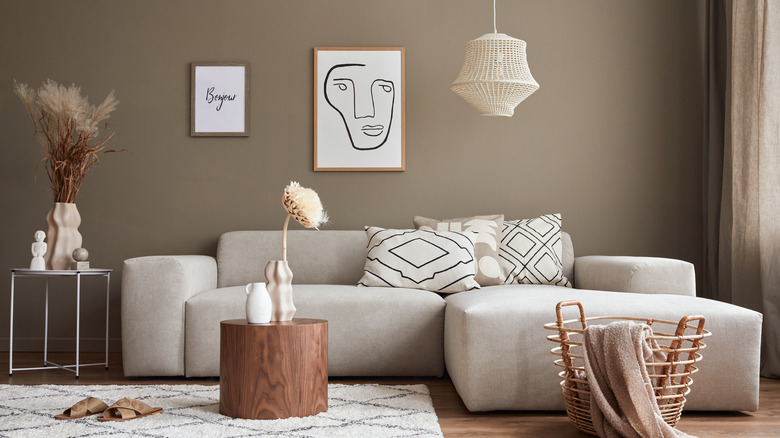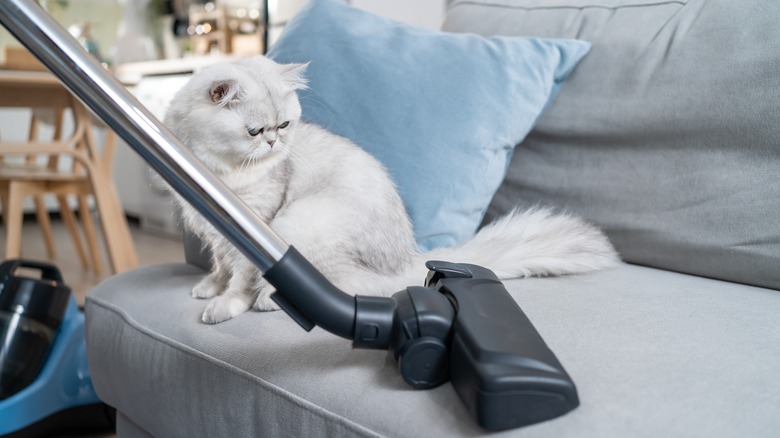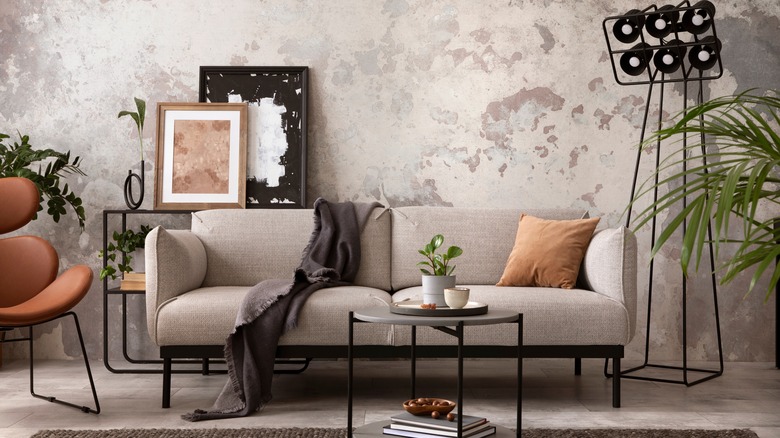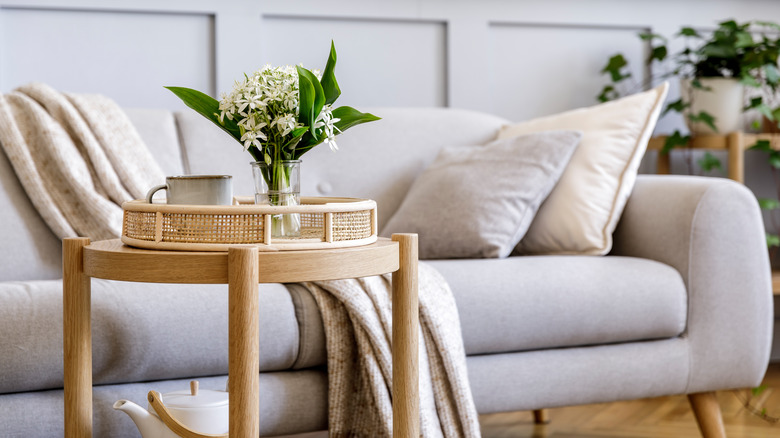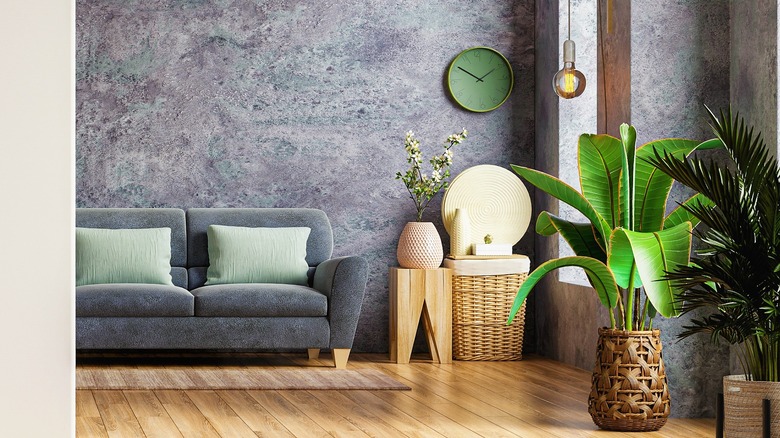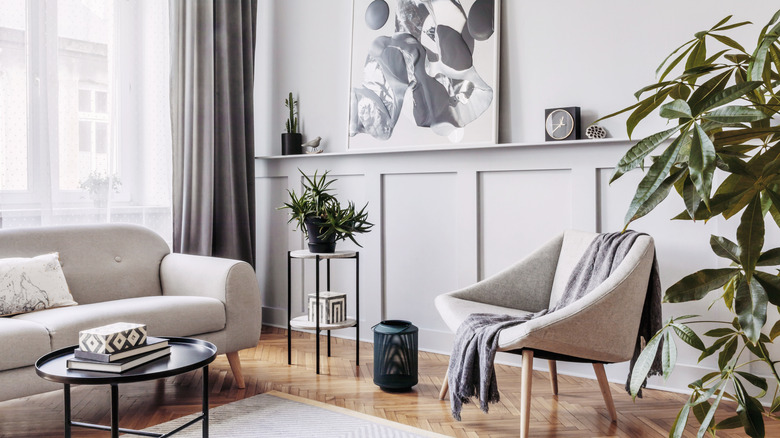5 Tips For Staging Your Living Room Like A Pro
Staging a house for potential buyers is a lot like staging a play. If you keep in mind the basics set down by real estate professionals, you'll find they're similar to Broadway directors. Most have two driving precepts in mind: One is to sell your home and the other is helping visitors picture themselves living there.
However, you still may be asking yourself why it's necessary to display furniture and accessories that aren't yours in the first place. Well, for starters, staging is one of the most dependable ways to maximize your home's selling price. According to the National Association of Realtors, 23% of buyers' agents said doing so raised the dollar value offered between 1% and 5% compared to residences on the market that hadn't. Beyond that, a whopping 18% claimed it boosted dollar values from 6% to 10%.
And while Realtors do realize the benefits of staging a home completely, the most important spot is the living room, according to Money. However, the costs aren't insignificant. In fact, a consultation can run you anywhere between $150 and $600. You'll also pay $500 to $600 per month while rented furniture sits in your home. Of course, there is some magic to staging a living room, but you can become a magician, too. Here are the top five home styling tricks you can perform on your own.
1. Clean up
To begin this process, it's important to inventory your entire living room. Every possible item that could delight or intrigue a prospective buyer needs to stay. Conversely, anything that could blunt their interest should go either into storage or the trash. My Mortgage Insider detailed a list of potential turnoffs, such as unpleasant (or all-too-identifiable) odors, exotic or frayed carpets, and layouts that aren't conducive to foot traffic.
But there are several other, more obscure elements to also keep in mind: gaudy family photograph displays, idiosyncratic color choices, and light bulbs that appear from another time and place. Your best bet? Strip the room bare (in your mind) and build it up again from there. Clean thoroughly — from the baseboards to the moulding — with extra attention paid to the ceiling and its corners. If the room needs a fresh coat of paint either to freshen its appeal or mute a color that's too loud, this is the moment to do so.
Next, Stage My Own Home.com suggests examining your living room from the perspective of an architect. Ask yourself, "What's the most attractive focal point?" Perhaps it's the mantel or a particularly beautiful view out one window or another. Or, maybe it's the exposed brick, French doors, or a fireplace. When staging your living room, make sure to highlight these and other important features.
2. Décor choices
Now that you're reassembling your living room for public viewing, think in terms of proportion. You don't want this space to look as empty as supermarket shelves just before a hurricane, nor should it resemble the home of a pack rat. According to the experts at MHM Professional Staging, LLC, your living room should feel inviting, without it bearing a resemblance to your place or anyone else's. That means your books, DVDs, and CD collection, (if you're old school like that) or sculptures and nick-knacks, should be kept to a minimum, with only the most innocuous and generic remaining out for display.
When it comes time for furniture to re-enter the picture, have a hard conversation with yourself. What pieces present the most flattering image of your living room? Are they in proportion to the rest of the area? Indeed, you don't want your living room to look like a closet full of overstuffed furniture. Conversely, you don't want it to feel swallowed up by plush couches and chairs. And remember: Don't place any pieces against the walls.
This is also no time to try to surprise people. After all, you're looking to welcome them and hint at what they might expect if they were to purchase your home. That means all the advice about painting your walls should apply to what you choose to showcase as well. Edit out any loud patterns and lean into the most neutral color schemes.
3. Tasteful accessories
One of the keys to staging décor is creating a flow by balancing colors and textures, from hardwood floors to similar textures that appear elsewhere in the room. The idea is to carry those concepts through to their logical conclusion. With that in mind, consider what you're working with at home. Are your curtains too heavy or sheer? Do they let in enough light? Are they color-balanced with other pieces in the room? What about your lamps? You don't want faded or stained lampshades or displays that look like hand-me-downs from your grandma.
Next, take a 360-degree look around your living room and examine whether it's full enough or looks bare. Recessed or built-in bookshelves make a terrific selling point, but don't clutter them with memorabilia. A few kindly placed magazines, selected more for appearance than content, are just right. If the room could use more space or light, add an unobtrusive mirror.
The folks at Home Staging Resources can help stage your living room by connecting you with a variety of products, from wicker accents to couch pillows and rugs. For example, stools made of banana fiber or wicker (IKEA has one for $59.99) are stackable and add the perfect accent and dimension to your living room. Likewise, Virtually Staging Properties explains that rugs serve a valuable purpose in staging, too, as they help pull your room together, separate spaces, and add light.
4. Plant 'em
To paraphrase DIY Home Staging Tips, place plants only in the rooms you wish to sell. In other words, every room should have a plant on display. But for the purposes of the topic at hand, let's talk specifically about what works best in the living room.
In general, be as smart in gathering plants and their containers as you are in assembling the right living room furniture. Avoid discount stores and seasonal outlets because their objective is to move products — not to care for plants. Instead, locate a nearby nursery and track down professionals who can offer sage advice. Tell them what the plants are for and where they'll be in relation to light sources. Most will be glad to help.
Doing this allows you to bust out your artistic side. However, you negate the overall purpose if any plants are placed in a pot or vase that detracts from the overall aesthetic you want to create. Still, it bears repeating: Less is often more, and you don't want to display anything that someone might consider over-the-top. That goes for your plant selection, too. Remember to keep their size in proportion to your living room.
Again, you're trying to highlight the room's best attributes. If you have those French doors, make them pop with a potted plant on either side. The experts at Lively Root recommend a wide selection of plants, from palms to ferns and beyond.
5. Test flight
Congratulations! You're almost there and likely already saved hundreds, if not thousands, of dollars in staging your living room without the help of professionals. But the job still may not be complete. In the words of Coco Chanel, "Before you leave the house, look in the mirror and take one thing off. It is always better to be underdressed" (via Vogue). And if your background isn't in interior design, get a second and third opinion about your work before flinging open the living room doors.
As a staging novice, you can also utilize checklists provided by the professionals you've been trying to imitate to get the biggest bang for your buck (via Virtuance). The company points out mistakes, like inadvertently letting your flatscreen become the focal point of your living room, and ways to tweak your work to perfection. They also talk about decorating with specific, easy-to-understand instructions — did you know there's eye appeal in groups of three? — and how to create focal points in your living room, even if they're not there architecturally.
